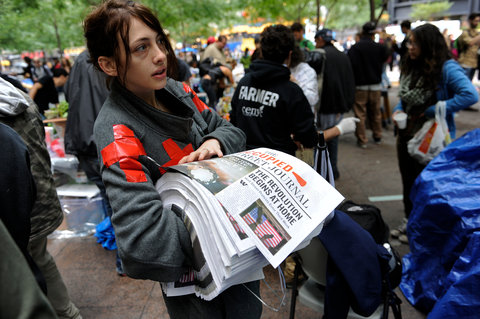 Today the first edition of the Occupied Wall Street Journal is making the
rounds, hand to hand, in New York City. In this “public art project,” articles by
Journal co-founder Arun Gupta and former NY Times reporter Chris Hedges sit alongside a
“Declaration of the Occupation.”
Today the first edition of the Occupied Wall Street Journal is making the
rounds, hand to hand, in New York City. In this “public art project,” articles by
Journal co-founder Arun Gupta and former NY Times reporter Chris Hedges sit alongside a
“Declaration of the Occupation.”
The growing occupation of the New York City financial district has caught the attention of news organizations around the country, but not to the extent, or with the depth and care, that those taking part would like. In response, Gupta and his partner Jed Brandt put together Occupy Wall Street Media to take the message into their own hands. As important as it is to work on catching the eye of mainstream media, any potential movement needs to take action to shape its own narrative. Gupta brings a lot of experience in this, as the general manager of the Indypendent, a free NYC-based progressive newspaper, affiliated with New York Indymedia.
Though I have yet to get my hands on a copy, a number of things about this paper are exciting to me, beyond simply the importance of such media projects in general. First of all, I love the name. Really, there was no other choice, but still it’s a great play on the Wall Street Journal, the title and image of which has become much more than a newspaper — it’s a meme that carries a story of capitalism, progress, and America to the world. At the same time, the title itself advertises the movement and it’s plan of action (however diffuse).
Secondly, I’m intrigued by the way that old and new media tools are being combined in the production of the paper. On the one hand, the project was funded in a very modern, Web-2.0 fashion. The founders posted their project on Kickstarter, a platform for funding creative projects through online donations. But the end result is a traditional broadside paper. While this limits the range of the audience (some of the material can be found online anyway), it facilitates person-to-person interactions at the site of the occupation, and a tool for approaching bystanders with information in an attractive format and full-color photos.
I don’t know how effective the paper will be. I’m reminded of the omnipresent socialist papers that always seem to get handed out by the same couple of people at every protest I have ever attended. Despite what may be interesting articles, many of these papers get brushed off by protesters (not to mention bystanders) as they are often not related in any specific way to the demands or organizations at the protest, and the distributors are usually not part of the organizing — they seem to be there just to push their own agendas. But in this case the paper is emerging directly from protest-ground-zero, and has the potential to help give some shape and narrative unity to what is being critiqued as too-diffuse an assemblage.
You can still donate to the effort at Kickstarter. I’m sending in a donation, so I will soon get to see the paper in my mailbox. I’m looking forward to checking it out.




Please print Mario Savio’s speech at the Berkeley Free Speech Movement sit-in at Sproul Hall on December 3, 1964. There is a time when the operation of the machine becomes so odious, makes you so sick at heart, that you can’t take part. You can’t even passively take part, and you’ve got to put your bodies upon the gears and upon the levers, upon all the apparatus, and you’ve got to make it stop. And you’ve got to indicate to the the people who own it, that unless you’re free, the machine will be prevented from working at all!
thank you and god bless you alllll!!!!!!!!
Are loan modifications on the agenda? JP Morgan Chase likes to pretend loan mods. are on their agenda, but only so they can collect government funds!!